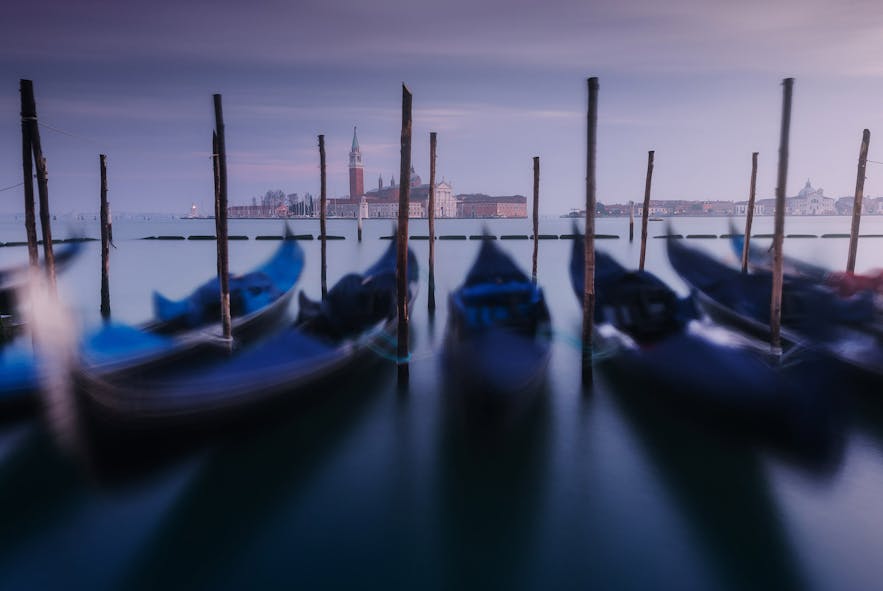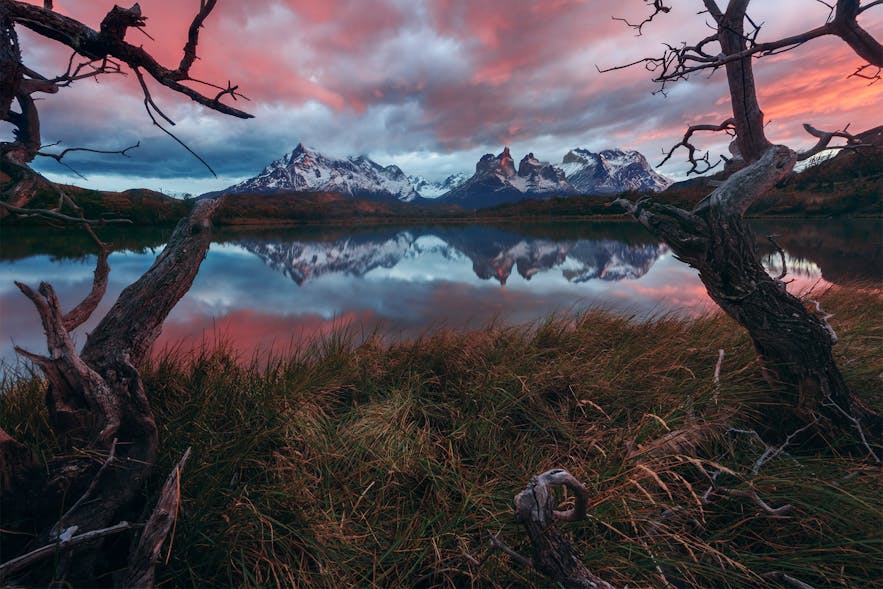
Horizontal Lines as a Compositional Tool in Photography
- What is a Horizontal Line in Photography?
- What Are Horizontal Lines Used For?
- How to Use Horizontal Lines in Photography
- Case Study #1: Broken Horizon with a Leading Line
- Case Study #2: Broken Horizon with Perpendicular Lines
- Case Study #3: Leading Lines Blending into the Horizon
- Case Study #4: Horizontal Lines to Frame the Subject
- Case Study #5: Horizontal Lines as the Division Point of the Image
- Tips for Using Horizontal Lines
- Tip #1: Set a Goal
- Tip #2: Choose the Right Focal Length
- Tip #3: Try Different Perspectives
- Conclusion

Horizontal lines are everywhere. Look at the photo above or at any other photo you prefer. Now look at the upper and lower edges. Do you see them? Even the two borders of any photo ever taken are horizontal lines. Photos are literally framed between two horizontal (and well, two vertical) lines.
- Learn all about Landscape Photography Composition Techniques | The S Curve
- Discover the Ultimate Guide to Composition in Photography
Having a decent knowledge of how to use horizontal lines properly in your frames is a good start to creating interesting images. Usually, horizontal lines will impart a static look to your shots, so unless that's what you are looking for then it pays to get some good advice on how to place them wisely.
In this article, we'll take a look at what a horizontal line is and how you can use them to improve your photography.
What is a Horizontal Line in Photography?
A horizontal line is a straight line that runs from the left side of the frame to the right. The most commonly used horizontal line in photography genres that are practiced outdoors is the Earth's horizon – the apparent line that separates the land from the sky.
Horizontal lines also exist in buildings when shooting architecture or cityscape photographs, as well as in studio sessions if you set up your subject accordingly.
 A white line has been drawn over the horizon. Photo by: 'Leonardo Papèra'.
A white line has been drawn over the horizon. Photo by: 'Leonardo Papèra'.
Here is an example of a horizontal line. In the shot above, I have drawn a white line over the horizon to show you what is considered to be a horizontal line in photography. In this case, it is quite recognisable. However, not all horizontal lines are as easy to spot as that.
 An obscured horizon line. Photo by: 'Leonardo Papèra'.
An obscured horizon line. Photo by: 'Leonardo Papèra'.
In this image, the horizon is still present but obscured by other compositional elements, such as the mountain, the lake and the hills in the background.
What Are Horizontal Lines Used For?
Since we are so used to seeing horizontal lines all around us, it’s not easy to make them stand out in photos. If you don't use them in the right way, then they can look pretty much uninteresting and dull.
 Horizontal lines can be used to increase the level of interest in your compositions. Photo by: 'Unsplash'.
Horizontal lines can be used to increase the level of interest in your compositions. Photo by: 'Unsplash'.
Including horizontal lines in your pictures can change the atmosphere of the scenes, as well as the feelings that you can evoke from your audience. Although horizontal lines can give a static look to your images, they can also produce fascinatingly extraordinary results by balancing a composition for a sense of stability and peace.
 Horizontal lines are an easy tool to use for improving your compositions. Photo by: 'Unplash'.
Horizontal lines are an easy tool to use for improving your compositions. Photo by: 'Unplash'.
The problem is that the line between creating a thoughtful image that has a static atmosphere as opposed to a dull one is incredibly thin. As such, when you use horizontal lines in the frame, you need to think about what kinds of feelings you want to convey and if it's better to remove the lines, to make them less prominent or to enhance them to fit the look that you're going for.
How to Use Horizontal Lines in Photography
So, here we are at the juicy chapter of the article – the one where we'll take a look at a few case studies on the use of horizontal lines in photography. I’ll use some of my pictures to show you how horizontal lines affect the overall look of the image.
Case Study #1: Broken Horizon with a Leading Line
Let’s start with the assumption that generally, an unbroken horizon can appear to be quite boring to the viewer. A great way to create more interest in an otherwise dull picture is to intersect some elements from other parts of the image over the horizon.
 Intersecting a curved line with the horizontal line of the horizon adds interest to this otherwise static image. Photo by: 'Leonardo Papèra'.
Intersecting a curved line with the horizontal line of the horizon adds interest to this otherwise static image. Photo by: 'Leonardo Papèra'.
The image above was taken in Dubai. To start, try to imagine the picture without the curvy bridge on the right side. It would be a classic reflection shot, without anything that would lead the eyes of the viewer to the main subject (the buildings).
Without the bridge, it would still be a decent photo, as the lights and the night-time atmosphere would partially make up for any lack of leading lines. However, it would definitely not have the same visual power of the image above.
The reason for this is that the leading line of the curved bridge creates depth, while breaking the horizon line to incorporate other parts of the frame adds interest.
Case Study #2: Broken Horizon with Perpendicular Lines
In the first case study, we looked at how to break the horizon line with the help of a leading line. You can also use vertical lines to intersect the horizon, creating a much more interesting result.
 Vertical lines intersecting with horizontal lines. Photo by: 'Leonardo Papèra'.
Vertical lines intersecting with horizontal lines. Photo by: 'Leonardo Papèra'.
When using this technique, it's important that you are careful not to create a chaotic composition, whereby the viewer has too many things to look at. This can cause general confusion as the viewer's eye is dragged all around the frame in search of the main subject. It's easy to mess things up when using vertical lines to interrupt the flat horizon line, so if you're not careful, then you may make your composition even worse.
Try to imagine the image above without the wooden poles rising from the water between the gondolas. The image would appear to be cleaner, though it would also be more static. The poles serve the function adding depth of field and to create some sort of tension (and instability) in an otherwise calm and peaceful frame.
Case Study #3: Leading Lines Blending into the Horizon
You can create more interest in horizontal lines by converging all of the other leading lines within the frame.
 Leading lines converging in a horizontal line. Photo by: 'Leonardo Papèra'.
Leading lines converging in a horizontal line. Photo by: 'Leonardo Papèra'.
In the image above, I used the horizon as an anchor point within the image. In combination with symmetry and light, I was able to incorporate the rows of lavender as converging lines towards the two trees in the background.
The final result is a static yet peaceful atmosphere. If your aim is to create some kind of drama or tension in the image, then I would recommend that you use a “broken” horizon, like we’ve previously seen above in the other examples.
Case Study #4: Horizontal Lines to Frame the Subject
We are “forced” to see horizontal lines in every photograph that we produce. The reason for this is that the images come out from our cameras framed as rectangles. Regardless, you can still enforce horizontal lines within your pictures to frame your subject, just as in the image below.
 Horizontal lines framing the vertical lines. Photo by: 'Leonardo Papèra'.
Horizontal lines framing the vertical lines. Photo by: 'Leonardo Papèra'.
The vertical lines may be interesting but on their own, they aren't able to create enough interest in the picture. By adding and overexposing the snow in the upper and lower parts of the frame, I created a sense of confusion and loss, arising from the fact that the viewer won't really know what is happening at the edges of the image. The function of these two horizontal lines is to give the idea that the vertical lines are starting from and ending in the unknown, as though they are floating in the air.
- See also: Rule of Thirds Explained
Case Study #5: Horizontal Lines as the Division Point of the Image
Most commonly, horizontal lines tend to arise as the division point of the image when you are shooting reflections. Reflections can be beautiful and strong enough to hold the composition of a photo without the help of leading lines.
 A horizontal line used as a division point. Photo by: 'Leonardo Papèra'.
A horizontal line used as a division point. Photo by: 'Leonardo Papèra'.
To use the horizon as a division point, you'll just need to make sure that you balance the placement of the horizontal line. The rule of thirds is great for this.
Tips for Using Horizontal Lines
Now that we have taken a look at a few examples of how to use horizontal lines in photography, it’s time for me to share a few tips about what you can do to use them successfully.
Tip #1: Set a Goal
I've already hinted at this a couple of times during the article but let me be clear: to make horizontal lines work in your frame, you’ll need to know what you want to achieve with that specific picture. Are you looking for a serene, peaceful atmosphere or something that is more dramatic and chaotic? This is something that you'll most definitely need to consider when working with horizontal lines, as even small changes to the composition can result in a huge difference in the final image.
 Have a goal when using horizontal lines in your images. Photo by: 'Leonardo Papèra'.
Have a goal when using horizontal lines in your images. Photo by: 'Leonardo Papèra'.
So, the tip is: think about what kind of look and atmosphere you want your shot to assume, before you release that shutter.
Tip #2: Choose the Right Focal Length
Different lenses mean different amounts of distortion, which can have an effect on the straightness of your lines. So, how does this translate in practical terms?
 The focal length that you choose to use can emphasise or reduce the importance of horizontal lines. Photo by: 'Leonardo Papèra'.
The focal length that you choose to use can emphasise or reduce the importance of horizontal lines. Photo by: 'Leonardo Papèra'.
By changing which focal length you use in-field, you can either emphasise or reduce the importance of horizontal lines within your frame.
When you use a super wide angle lens, then unless the horizon is far away, all of the horizontal lines (as well as the vertical lines) will be stretched as a result of lens distortion. On the other hand, if you use a telephoto lens, then the lines will be enhanced by the lack of distortion.
Which focal length is the best option to use? That just depends on how much you want to draw the eye to the horizontal lines within your frame.
Tip #3: Try Different Perspectives
As photographers, we are not magicians who already know which compositions will work in each possible situation. If you're anything like me, then you'll need to snap at least a few different images to understand which composition is the best.
 Try different perspectives with horizontal lines. Photo by: 'Leonardo Papèra'.
Try different perspectives with horizontal lines. Photo by: 'Leonardo Papèra'.
If you start shooting from a lower perspective, then it's worthwhile getting higher to see if it might work better and vice versa. You might find that the composition gets too messy. Alternatively, you may find that you are able to use vertical lines to break the horizon line.
By trying different perspectives, you'll be able to work out which composition suits the scene. You may find new horizontal lines to add in your frame or to hide some of the ones that are already in it.
 Horizontal lines are a great way to improve your compositions. Photo by: 'Unsplash'.
Horizontal lines are a great way to improve your compositions. Photo by: 'Unsplash'.
Conclusion
Horizontal lines are an often underestimated notion when it comes to composition in photography. The truth is that they are a seriously important part of the image. If you pay attention to them, then you may be surprised by how many there are in a lot of the images that you see.
Horizontal lines must be taken into consideration in order to improve the composition and the atmosphere of your images. By using them wisely, you'll be able to make a huge leap forward in your photography!
About the author: Leonardo Papèra is a landscape and nature photographer based in Italy. You can find more of his work on his website or by following him on Instagram.
Improve your compositions in-field with our expert photography guides! Join us on a Photography Workshop in Iceland.
Other interesting articles

When to Use a Narrow or Wide Aperture for Photography
Aperture is one of the most important styling tools in photography, so it is important to learn and understand how this camera setting can change your photographs to create a desired effect. Apertur...Read more
How to Use Balance for Better Compositions in Photography
Knowing how to properly compose your pictures is what will make them stand out from the crowd. While photographic technique is also important, if you don’t manage to find a great composition, then y...Read more
Ultimate Guide to Composition in Photography
Almost all new photographers list getting better at composition as something that they struggle with. That makes a lot of sense and unfortunately, composition is one of the most difficult things to...Read more
















